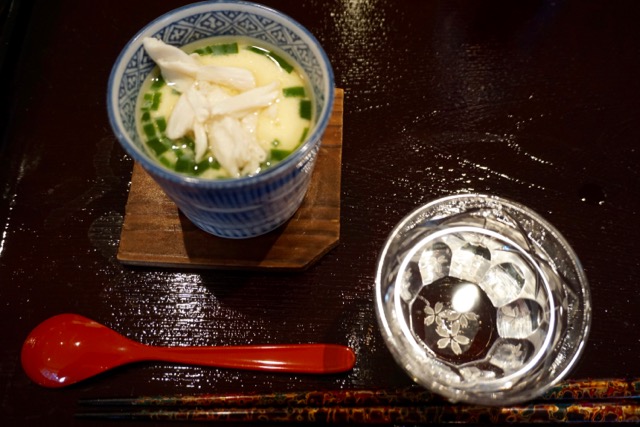All green and, perhaps, it would have been perfect for St. Patrick's day.
I decided to add more bright colors and made two kinds of sweet pepper coulis (red and yellow) and sweet vinegar marinated red radish slices.
I think I may have overdone it, this time. Maybe a little less red color would have been more "restful to the eye".
Ingredients(for Cauliflower panna cotta, about 8 servings):
Cauliflower, 1 medium head, separated into florets, washed.
Spinach, one bag, cooked in a covered pan without adding any liquid. excess moisture squeezed out #2).
Onion, two, medium, cut into thin strips.
Garlic, two cloves with skin on.
Milk, enough to cover the cauliflower (#1)
Butter, unsalted, 3 tbs
Directions.
1. Add the cauliflower, onion,, garlic, and butter to a saucepan and cover it with milk. Simmer it until the cauliflower is cooked (#1, about 30 minutes) (see P.S. below).
Alternatively, we need not cook the cauliflower in milk. Instead we could cook the cauliflower by steaming, sweat the onions in a pan then use milk to puree the two together. Then we could heat some milk with about 3tbs of butter in it to bloom the gelatin and that milk would give the proper texture.
2. Strain the cauliflower and milk mixture through a sieve, reserving the milk (My wife figured adding butter will make the milk more cream-like).
3. In two batches, I placed vegetables in a blender and added enough milk to puree (with our blender on high speed, it took 30-40 seconds to have a nice smooth puree, #3 and 4).
I added one of the garlic clover after squeezing it out of the skin in one of the batches. After tasting this batch, I did not add the garlic to the other batch.
4. I combined the puree in a bowl (#5) and tasted. I added few pinches of salt which made the sweetness of the vegetables to come out.
5. I sprinkled 3 envelopes of unflavored gelatin on about a half cup from the remaining milk (still hot) and whisked it to dissolve and then added to the puree making sure all the gelatin was dissolved into the puree.
6. I poured the final mixture into small individual ramekins (#6).
7. Covered them with plastic wrap and refrigerated until set (several hours).
8. To unmold, I placed the ramekin in hot water for few seconds and also ran a thin bamboo skewer (or a thin narrow knife blade) around the edge and inverted on the center of the plate.
Ingredients (For sweet pepper coulis):
Red and yellow sweet pepper, 1 each
Shallots, 3, finely chopped and sauteed in olive oil until soft
Vinegar (I used rice vinegar) 4 tsp
Olive oil (EVOO) 4-6 tbs
Salt
Directions:
1. I roasted the peppers in the toaster oven on broil mode, for about 20 minutes, turning every five minutes so that all the surfaces got slightly blackened. I immediately placed them in a Ziploc bag and let them steam for 10-20 minutes or until cooled down (#1).
2. I removed the skin, stem end and seeds (#2).
3. Cut it in small cubes (#3).
4. Place the #3, half of the shallot, juice accumulated in the bag, vinegar, and EVOO in a blending container (#4).
5. Using an immersion blender in high speed, blended into thin sauce (#5). If the consistency is too thick, you could add a bit of water. I tasted and added a pinch of salt.
6. I repeated for the yellow pepper to make red and yellow pepper coulis (#6).
Ingredients (For pickled red radish):
Small red radish, 3, top and bottom end removed, sliced into thin rounds (I used a Japanese mandoline).
Sweet vinegar, 1/4 cup (I took a short cut, and poured sushi vinegar from a bottle into a Pyrex ramekin with 2 tsp of sugar, and microwaved until the vinegar was warm and the sugar melted).
I immediately marinated the radish slices, covered with plastic wrap and let sit for a few hours. The red color leached out and the radish slices become a nice homogeneous pink.
P.S. Some days later, since I had a head of cauliflower which was already one week old, I decided to make cauliflower puree. I followed the recipe from the Washington Post. As per the recipe, I first steamed the cauliflower for 8 minutes and made a puree using my Cuisinart. But the result was disappointing with a mealy texture despite the fact I ran the food processor for quite some time. It never attained the smooth and creamy puree my wife made in the current recipe. I thought it had something to do with how the cauliflower was cooked. She cooked the cauliflower in milk and butter. Disappointed, I just put my cauliflower puree in a sealed container in the fridge thinking I would have to come up with a way to use it.
The same day, my wife wanted to try the English pea pannacotta she had originally wanted to make using the original recipe, since we had all the ingredients this time. When we pureed the peas, we used the blender instead of the cuisinart, and the pea puree came out very smooth and velvety. We didn't even have to sieve it. It dawned on me that maybe I should have run my cauliflower puree through the blender instead of the cuisinart. So I retrieved my coarse textured puree added a bit more milk and let it whir. The result was amazing. My cauliflower puree became silky smooth. Moral of the story, use the blender to make cauliflower or pea puree--not the cuisinart.










































